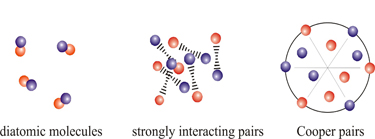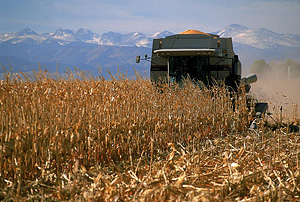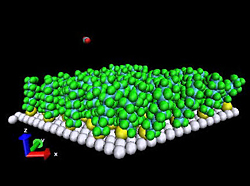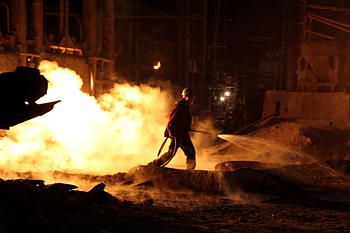| August 6, 2008

[NIST Tech Beat Search] [Credits] [NIST Tech Beat Archives] [Media Contacts] [Subscription Information]

New Technique Reveals Hidden Properties of Ultracold Atomic Gases
 |
A powerful new JILA technique reveals hidden properties of ultracold atoms in a superfluid, in which atoms form pairs like electrons in a superconductor. The JILA group focuses on the "crossover" stage (middle graphic) between the small pairs of a Bose-Einstein Condensate (left) and the extremely large pairs of a low-temperature superconductor (right).
Credit: C. Regal/JILA
View hi-resolution image |
Physicists at JILA, a joint institute of the National Institute of Standards and Technology (NIST) and the University of Colorado at Boulder, have demonstrated a powerful new technique that reveals hidden properties of ultracold atomic gases.
To develop the new technique, the scientists borrowed an idea used for nearly a century in the study of materials: photoemission spectroscopy. Traditional photoemission spectroscopy probes the energy of electrons in a material. The new photoemission spectroscopy technique, described in the Aug. 7 issue of Nature,* adapts this technique to study potassium atoms in an ultracold gas.
Photoemission spectroscopy is particularly powerful in revealing details of the pairing of electrons in high-temperature superconductors, which are solids that have zero resistance to electrical current at relatively high temperatures (but still below room temperature). The scientists at JILA study a very similar phenomenon: superfluidity (fluids that can flow with zero friction). Specifically, they study how atoms in a Fermi gas behave as they "cross over" from acting like a Bose Einstein Condensate (in which fermions pair up to form tightly bound molecules) to behaving like pairs of separated electrons in a superconductor.
In the crossover region, atoms in an ultracold gas exert very strong forces on each other, which masks their individual properties. To see the hidden behavior, JILA scientists apply a radio frequency field to a cloud of trapped, paired potassium atoms, ejecting a few atoms from the strongly interacting cloud. Then the laser trap is turned off so the gas can expand. Scientists make images and count the numbers of escaping atoms at different velocities. With this information, scientists can calculate the atoms' original energy states and momentum values back when they were inside the gas. Scientists then map the energy levels for all the original states of the atoms and can identify a particular pattern that shows the appearance of a large "energy gap," which represents the amount of energy needed to break apart a pair of atoms.
The new photoemission technique represents a huge jump in the information available to physicists who study ultracold gases. Traditionally, scientists could probe either the energy or momentum of these gases, not both. The new technique simultaneously probes the energy and momentum, allowing the scientists to study the microscopics involved in the pairing of two atoms.
"This technique is a clean probe of the microscopics in this system, and it allows us to see interesting things like a very large energy gap that seems to appear before the superfluid state," says group leader Deborah Jin, a JILA/NIST fellow. Another research group previously identified what seemed to be an energy gap; however, the results of the JILA technique are much clearer to interpret, Jin says.
Ultimately, the JILA work studying superfluidity in atomic gases may one day help in understanding the energy gap that appears in high-temperature superconductors, which may have applications such as more efficient transmission of electricity across power grids. In addition, the new technique can be extended beyond the study of pairing to include, for example, the study of atoms trapped in crisscrossed "lattices" of laser light, a building block for some atomic clock and quantum computer designs.
Funding for the research was provided by the National Science Foundation.
*J.T. Stewart, J.P. Gaebler and D.S. Jin. Using photoemission spectroscopy to probe a strongly interacting Fermi gas. Nature. Aug. 7, 2008.
Media Contact: Laura Ost, laura.ost@nist.gov, (303) 497-4880 

Improved Reaction Data Heat Up the Biofuels Harvest
 |
New NIST research results are a step toward more efficient production of cellulosic ethanol, a biofuel that can be made from corn-harvest leftovers—stalks, husks, leaves—and the inedible parts of other plants as well as a diverse array of abundant non-food plants such as switchgrass.
Credit: NREL photographer, Jim Yost |
High food prices, concern over dwindling supplies of fossil fuels and the desire for clean, renewable energy have led many to seek ways to make ethanol out of cellulosic sources such as wood, hay and switchgrass. But today’s processes are notoriously inefficient. In a new paper,* researchers at the National Institute of Standards and Technology (NIST) have detailed some of the most fundamental processes involved in extracting sugars from biomass, the first step in producing ethanol by fermentation. Their findings should help engineers to improve their process designs in order to extract the maximum amount of fuel from a given measure of biomass.
Most of the ethanol produced in the United States is created by fermenting the sugars and starch found in corn. The capability to convert inedible plants and agricultural waste into usable sources for ethanol production will help to supplement alternatives to fossil fuels while reducing the diversion of food crops to energy uses.
Glucose can be extracted from two substances found in most plants: cellulose, the long molecule chains that comprise the cell walls of green plants, and its flimsier cell-wall counterpart, hemicellulose. The extracted glucose is then easily converted by fermentation to ethanol. NIST researchers, in collaboration with the National Renewable Energy Laboratory in Golden, Colo., have defined the theoretical limits of reactions important to cleaving, or breaking apart, cellulose and hemicellulose to produce glucose. They also determined that the energy needed to rupture these key bonds is a constant value for each molecular bond that is broken during the cleavage reactions.
According to Yadu Tewari, Brian Lang and Robert Goldberg, chemists at NIST and co-authors of the paper, cellulose and hemicellulose both present problems to would-be ethanol producers.
“Cellulose and hemicellulose are recalcitrant,” Goldberg says. “They don’t want to break down. It takes a long time for wood to rot. It even takes termites a long time to break wood down, and they’re pretty good at it. Ethanol producers face the same problem. Because of the way these molecules are arranged, it’s difficult to get access to the reactive centers in wood and other biomass. What we have done is to study some of the most basic reactions associated with the breakdown of these materials.”
With enzymes to speed the reactions, the team used calorimetry and chromatography to measure the thermodynamic property values of several reactions associated with the breakdown of cellulosic and hemicellulosic substances. Because process design and bioengineering benefit from the availability of these values, the data obtained in this investigation represent a “small but significant step toward maximizing the efficiency of biomass utilization,” Tewari says.
* Y.B. Tewari, B.E. Lang, S.R. Decker and R.N. Goldberg. Thermodynamics of the hydrolysis reactions of 1,4-ß-D-xylobiose, 1,4-ß-D-xylotriose, D-cellobiose, and D-maltose. Journal of Chemical Thermodynamics. Available online at http://dx.doi.org/10.1016/j.jct.2008.05.015.
Media Contact: Mark Esser, mark.esser@nist.gov, (301) 975-8735 

Skipping Atomic-scale Stones to Study Some Chemistry Basics
 |
MOVIE CLIP - click image to play. Computer simulation of the JILA gas-liquid scattering experiments uses long molecules tethered to a surface as a useful stand-in for liquids, which are too complex for computer modeling. The speed of rotation of the carbon dioxide molecule after striking the surface is strongly dependant on its orientation, an effect caused by atomic-scale “waves” on the fluid surface. This movie clip requires Windows Media Player (or equivalent), a free download – click here.
Credit: Perkins, JILA |
Thought experiment: a carbon dioxide molecule—think of a cheerleader’s baton—comes slanting in at high speed over a dense liquid, strikes the surface and ricochets. How does it tumble? Fast or slow? Forward, backward or sideways? These are not idle questions because simple events like the tumbling molecule go to the heart of the chemistry and physics of gas-liquid interactions. These cover a broad swath of important chemical processes—including breathing—for which details of the encounter are just coming into view.
New experiments reported this week* from JILA in Boulder, Colo., are giving a uniquely detailed look at what happens when gas molecule meets fluid.
Historically, chemistry has been confined to observing the mass behavior of huge numbers of molecules—mix things together, look at the reaction products, infer what happened. Only in the past couple of decades have powerful lasers made it possible to “watch” specific events involving only a few molecules. Today, they can even observe the role played by a molecule’s shape, a critical influence in many interactions.
Now, Bradford Perkins, Jr., of the University of Colorado and David Nesbitt of the National Institute of Standards and Technology (NIST) report the first direct observation of the rotational dynamics of a molecule bouncing off a liquid surface.
Perkins and Nesbitt directed a beam of carbon dioxide molecules at a pool of synthetic fluorinated fluid in a vacuum. The molecules that bounced off passed through an infrared laser beam, which switched rapidly between alternate orientations, or polarization states. A sensitive detector measured how much light was absorbed by the passing molecules.
A rod-like carbon dioxide molecule will absorb with slightly different efficiencies depending on how it rotates relative to the light’s polarization. Analyzing the oscillating signal allowed the team to observe just how fast and in what direction the molecules were tumbling after hitting the fluid. They found the molecules had a pronounced tendency for a forward, end-over-end “top spin,” as if hit by a star Wimbledon tennis player, with the rate of tumbling strongly correlated with how its molecular rotation is aligned relative to the light path.
“To know how this happens at the molecular level—how things bounce, skip, spin, tumble, push and pull—represents a big leap in our understanding,” says Nesbitt. “Experiments of this sort help build that understanding.”
In addition, Nesbitt says, observing how gas molecules of different shapes twist and rotate after striking a liquid reveals a lot about the nature of the fluid surface—how “rough” it is from the disturbance of microscopic waves and how that roughness affects interactions with gases.
JILA is a research institution operated jointly by NIST and the University of Colorado. The research was supported by the Air Force Office of Scientific Research and the National Science Foundation.
* B.G. Perkins, Jr., and D.J. Nesbitt. Stereodynamics in state-resolve scattering at the gas-liquid interface. Proceedings of the National Academy of Science, Early Edition.
Media Contact: Michael Baum, michael.baum@nist.gov, (301) 975-2763 

NIST Debuts New Approach to Ad Hoc Networks for First Responders
 |
Conditions at building fires, mine collapses and other disasters in enclosed environments can severely disrupt two-way communications between first responders and command posts. NIST scientists have developed a prototype solution—an automated system of smart “breadcrumb” relays that can be deployed on the fly to extend the communication range.
Copyright: Shutterstock |
National Institute of Standards and Technology (NIST) researchers successfully demonstrated a prototype approach to maintain two-way communications with first responders as they make their way in building fires, and mine and tunnel collapses. These and other disasters in enclosed environments are often rife with radio dead spots and conditions that can severely weaken signals.
On Aug. 5, in conjunction with the 2008 Workshop on Precision Indoor Personnel Location and Tracking for Emergency Responders at Worcester Polytechnic Institute in Massachusetts, NIST information technology experts put their version of a “breadcrumb communication system” through its paces. The system is highly automated so that it can be deployed on the fly. It features “smart” multihop relays—sometimes referred to as “breadcrumbs”—that, in effect, advise first responders when to place the next device so as to extend the communications range.
Assembled from off-the-shelf microprocessors and other standard hardware, the relays incorporate NIST-developed software that monitors the status of radio communication signals. The algorithms embedded in the software rapidly assess the strength of received signals so that the device can automatically alert first responders to lay down the next relay before they walk out of range and lose the radio signal.
Other approaches to setting up ad hoc wireless networks in emergency situations typically instruct first responders to lay down breadcrumb relays, for example, in distance increments, around every corner in corridors, or in every stairwell. “Static rules do not take into account all the environmental variables that affect signal degradation, such as attenuation, fading and interference,” explains NIST’s Nader Moayeri. “The communication range in a commercial building corridor is vastly different from that of a factory floor, which is unlike a coal mine.”
That’s why Moayeri, Michael Souryal and other members of the NIST team developed software that implements an “adaptive strategy” for maintaining connectivity. Their approach builds on NIST’s extensive research on measuring and monitoring radio signals in buildings.
Automated deployment of relays, Moayeri says, is a key performance requirement because it does not divert the attention of emergency personnel. The NIST software also provides advice on placement to improve the robustness of signals. The NIST researchers evaluated their adaptive breadcrumb deployment strategy in computer simulations of a wide variety of emergency scenarios and in several field tests. Tests were conducted with two prototype breadcrumb radio systems developed at NIST, one operating at 900 megahertz and the other at 2.4 gigahertz.
Candidate approaches to maintaining continuous communication links between responders and incident command centers were evaluated on the basis of number of signal packets lost in transmissions, number of relays deployed, and delays in end-to-end communications.
The NIST team is interested in sharing their prototype technology and its underlying concepts with businesses and other organizations working to improve the quality and reliability of first responder communication systems.
More information is available at: http://www.itl.nist.gov/rtm/
Media Contact: Mark Bello, mark.bello@nist.gov, (301) 975-3776 

Vegas ‘Quantum Spookshow’ Demos On-the-Fly Encryption of Streaming Video
Las Vegas shows often are on the cutting edge. Following this tradition, researchers from the National Institute of Standards and Technology (NIST) and their colleagues at the National University of Singapore (NUS) have landed gigs this week at Caesar's Palace and the Riviera Hotel and Casino to perform live demonstrations of quantum cryptography, theoretically the most secure form of encryption.
Appearing at two major venues of the information security industry, known as the Black Hat and DEFCON meetings,* the researchers will showcase the increasing practicality of quantum cryptography.
In the NIST portion of the "Quantum Spookshow," an exhibit-hall demonstration presented with NUS, a web cam will capture live video, scramble it using quantum cryptography, and broadcast the decrypted video. The bit rate of the quantum-encrypted video is targeted to exceed 300,000 bits per second (bps), a quality higher than that of popular video-sharing Web sites. The NUS group will demonstrate a reduced-size next-generation quantum cryptography system that uses pairs of interlinked or "entangled" photons and very simple hardware.
Aptly enough for the City of Lights, these two systems employ photons—particles of light—to create the secret key, a random series of digital bits, each representing 0 or 1, which is used to encrypt and decrypt messages in real time. In the NIST high-speed wireless setup, an infrared laser generates the photons while small telescopes with 8-inch mirrors send and receive the photons over the air. The system uses the most secure version of quantum key distribution (QKD), known as the "one-time pad," in which one bit of key is produced for every bit of video that is transmitted.
Once a secret key is created, it is used to encrypt video data, which then are sent over an Ethernet cable. The data are decrypted by a receiver in real time using PC-compatible circuit boards designed and built at NIST. With a transmission capability of up to a billion bps, the NIST system makes QKD practical for encrypting streaming video and other applications.
Nonetheless, there are points of weakness in any quantum cryptography system. At the demonstrations, participants will have a chance to discover vulnerabilities through hands-on interactions with the systems. In NIST's simplified setup, participants can put a filter in front of the telescopes, causing error rates to skyrocket and making it impossible to generate enough key to encrypt video. Identifying subtler security loopholes in real-world environments is a major research objective of practical quantum cryptography. Participants are invited to find and discuss security loopholes in the system: the NUS group has made their code open source, and it can be found at http://code.google.com/p/qcrypto.
The NIST work in this field was supported by the Defense Advanced Research Projects Agency, and includes researchers who work at the Joint Quantum Institute, a research partnership of NIST and the University of Maryland. The NUS component was supported by Singapore's Centre for Quantum Technologies and its Defense Science and Technology Agency (DSTA).
*Quantum Spookshow, at Black Hat Briefings, Caesar's Palace, Wednesday, Aug. 6, 1:30-7:30 p.m., and Thursday, Aug. 7, from 12:00 to 6:00 p.m.. At Defcon 16, Riviera Hotel and Casino, Friday, Aug. 8, and Saturday, Aug. 9. Also: Joshua Bienfang, "Free-Space Quantum Key Distribution at GHz Transmission Rates," Turbo Talk at Black Hat Briefings, Thursday, Aug. 7, 4:45 p.m.
Media Contact: Ben Stein, bstein@nist.gov, (301) 975-3097 

NIST, UMBI Host October Conference to Spur Bioscience Innovation
The National Institute of Standards and Technology (NIST) and the University of Maryland Biotechnology Institute (UMBI) will co-sponsor an international conference on “Accelerating Innovation in 21st Century Biosciences: Identifying the Measurement Standards and Technological Challenges,” Oct. 19-22, 2008, at NIST headquarters in Gaithersburg, Md. The conference goal is to identify and prioritize measurement, standards and technology needs currently creating barriers to innovation—and impeding full realization of the societal and economic benefits of new discoveries in the biosciences.
The conference will focus on:
- Agriculture—increasing yield, quality and safety in the world’s food supply;
- Energy—obtaining sustainable energy from biological sources;
- Environment—understanding our planet through linking molecules to ecosystems;
- Manufacturing—obtaining higher quality products through better bioprocess measurements; and
- Medicine—improving health through measurement of complex biological signatures.
The conference is designed to yield a detailed “road map” list of measurement, standards and technology needs that will inform and guide researchers at NIST, as well as others in the measurement and standards communities worldwide.
The conference will open with a session in which policy makers and National Metrology Institute directors from around the globe will discuss priority setting and budgeting for bioscience measurement and standards activities in their respective regions and countries. This will be followed by a series of plenary lectures from bioscience leaders discussing future trends and measurement, standards and technology needs.
Among the notables scheduled to speak at the conference are: John Marburger, director of the U.S. Office of Science and Technology Policy; Lee Hood, president, Institute for Systems Biology; Anna Palmisano, associate director, biological and environmental research, Office of Science, Department of Energy; Stephen Weisberg, executive director, Southern California Coastal Water Research Project Authority; James Thomas, vice president of process and analytical sciences, Amgen Corp.; and Pamela Ronald and Raoul Adamchak, authors of Tomorrow's Table.
For more information and to register online, go to http://www.cstl.nist.gov/Biosciences.html.
Media Contact: Michael E. Newman, michael.newman@nist.gov, (301) 975-3025 

Quick Links
NIST Advisory Group Welcomes Berkeley Professor
Ruzena Bajcsy, an electrical engineering and computer science professor at the University of California, Berkeley, has been chosen to serve on the primary private-sector policy advisory body of the National Institute of Standards and Technology (NIST). Bajcsy’s appointment to the agency’s Visiting Committee on Advanced Technology (VCAT) was announced by James M. Turner, NIST deputy director.
Bajcsy's varied research interests include artificial intelligence, robotics, biosystems and computational biology, and human-computer interaction. She is director emeritus of the Center for Information Technology Research in the Interest of Society (CITRIS), a UC-Berkeley-headquartered public-private partnership that develops information technology solutions to social, environmental and health care issues.
Prior to joining Berkeley in 2001, Bajcsy headed the Computer and Information Science and Engineering Directorate at the National Science Foundation. Author of more than 300 articles, book chapters and reports, Bajcsy is a member of the National Academy of Engineering and the Institute of Medicine.
The VCAT was established by Congress in 1988 to review and make recommendations on NIST’s policies, organization, budget and programs, and was recently updated by the 2007 America COMPETES Act. The next VCAT meeting will take place Oct. 28-29, 2008, in Boulder, Colo.
For a list of all members and more information, please see www.nist.gov/director/vcat/.

Updated Information Security Performance Measurement Guide Published
The quintessential guide to evaluating the effectiveness of security controls applied to information systems and information security programs has been updated to reflect recent security advances. The National Institute of Standards and Technology published Special Publication 800-55 Revision 1, Performance Measurement Guide for Information Security, in late July.
For the past five years, SP 800-55 has provided information technology and security professionals with a process for developing, selecting and implementing performance measures to facilitate decision making, improve performance and increase accountability. The guide describes how an agency can use its information system and program security controls to succeed in achieving its mission.
The update expands upon NIST’s previous work in this area. It provides additional program-level guidelines for measuring information security performance in support of organizational strategic goals. It also aligns performance measurement with the security controls in NIST SP 800-53, Recommended Security Controls for Federal Information Systems.
A PDF of the new SP 800-55 Revision 1 is available at: http://csrc.nist.gov/publications/PubsSPs.html#800-55_Rev1.

Three Experts Named to Earthquake Advisory Board
Three new experts have been tapped to serve on the Advisory Committee on Earthquake Hazards Reduction (ACEHR) of the National Earthquake Hazards Reduction Program (NEHRP) by James Turner, deputy director of the National Institute of Standards and Technology (NIST) and acting NEHRP chair.
Established by the Earthquake Hazards Reduction Act of 1977, NEHRP is the federal government’s program to reduce the risks to life and property from earthquakes. NEHRP consists of four federal agencies: the Federal Emergency Management Agency, the National Science Foundation, the United States Geological Survey and NIST, which serves as lead agency.
The new ACEHR members are: James E. Beavers, director, Construction Industry Research and Policy Center, University of Tennessee, Knoxville; Michael K. Lindell, professor, Department of Landscape Architecture and Urban Planning, Texas A&M University; and Brent H. Woodworth, president/CEO of Global Crisis Services, Inc., Calabasas, Calif. They join a group of 13 previously appointed academic, industry and government experts on the ACEHR.
The committee’s responsibilities include assessing trends and developments in the science and engineering of earthquake hazards reduction; overseeing the effectiveness of NEHRP in improving design and construction methods and practices; advancing prediction techniques and early-warning systems and carrying out other tasks assigned by Congress; and managing, coordinating and implementing NEHRP activities.
More information on NEHRP can be found at www.nehrp.gov.

|

